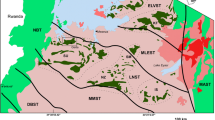Abstract
Gold deposits of the meso-epithermal carbonate type were first proposed based on the study of the Baguamiao gold deposit. This new type of gold deposits has many unique characteristics as follows: (1) Obviously strata-bound. The gold deposits are hosted in Middle Devonian turbidite formations; (2) Structurally controlled. Structure is an important factor leading to metallogenesis of this type of gold deposits. The shape and distribution of orebodies are controlled by brittle-ductile shear zones; (3) Multistage wall-rock alteration. According to the characteristics of mineral assemblage, gold mineralization can be classified into three stages in association with various wall-rock alterations. Wall-rock alterations closely genetically related to the gold mineralization are ankerization, silicification, pyrrhotization and pyritization; (4) Mineral compositions of the orebodies are mainly pyrrhotite, pyrite, marcasitolite, chalcopyrite, quartz, ankerite, and sericite. Gold mineralization is associated closely in space and time with iron sulfides; (5) Rare elements and REE in ores are low in contents relative to those of the crust. Au content varies from 1.91g/t to 11.15g/t, averaging 5.5g/t; (6) Studies of sulfur, hydrogen, oxygen and carbon isotopes in main gangue minerals (quartz and ankerite) indicate that fluids and ore-forming materials came from deep-seated sources; (7) Three types of inclusions are recognized in terms of their composition and the vapor amounts of inclusions. The homogenization temperatures of inclusions range from 210° C to 310° C, averaging 230° C, showing that this type of gold deposits belongs to the meso-epithermal type; (8) Metallogenic age of this type of gold deposits is similar to that of the collision between the Yangtze Plate and the North China Plate, indicating that gold deposits of this type are genetically related to continental-margin plate activity.
Similar content being viewed by others
References
Arehart, C.B., C.S. Eldridge, S.L. Chryssoulis, and S.E. Kesler, 1993, Ion microprobe determination of sulfur isotope variations in iron sulfides from the Post/Betze sediment-hosted disseminated gold deposit, Nevada, USA: Geochim. Cosmochim. Acta, v.57, p.1505–1519.
Hutchinson, R.W., 1987, Metallogeny of Precambrian gold deposits: space and time relationships: Econ. Geol., v.82, p.1993–2007.
Li Wenkang et al., 1993, Metallogenetic conditions of micrograined gold deposits in eastern Qinling: Beijing, Geological Publishing House, 134p.
Ohmoto and Hiroshi, 1972, Systematics of sulfur and carbon isotopes in hydrothermal ore deposits: Econ. Geol., v.67, p.551–578.
Radtke, A.S., R.O. Rye, and F.W. Dickson, 1974, Geology and stable isotope studies of the Carlin gold deposit, Nevada: Econ. Geol., v.75, p.641–672.
Rye, R.O. and Ohomoto, 1974, Sulfur and carbon isotopes and ore genesis: A review: Econ. Geol., v.69, p.862–842.
Taylor, H.P. Jr., 1974, The application of oxygen and hydrogen isotope studies to problems of hydrothermal alteration and ore deposit: Econ. Geol., v.69, p.843–883.
Wang, G.M. and S.H. White, 1993, Gold mineralization in shear zones within a turbidite terrane, examples from Ventral Victoria, S.E.Australia: Ore Geology Reviews, v.8, p.163–188.
Author information
Authors and Affiliations
Rights and permissions
About this article
Cite this article
Zuoping, Z., Xueyuan, Y. & Jian, G. A new genetic type of gold deposits-meso-epithermal carbonate-type gold deposits as exemplified by the Baguamiao superlarge gold deposit. Chin. J. of Geochem. 14, 83–92 (1995). https://doi.org/10.1007/BF02840387
Issue Date:
DOI: https://doi.org/10.1007/BF02840387




